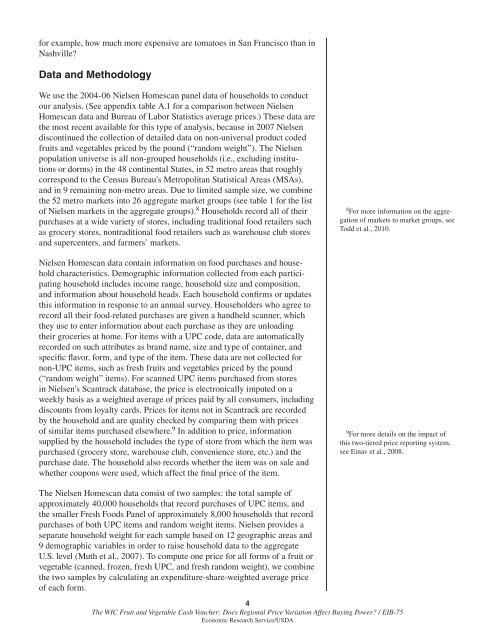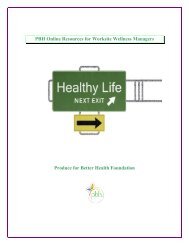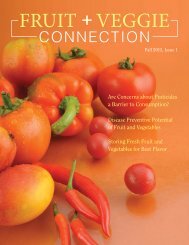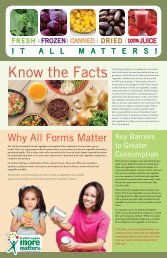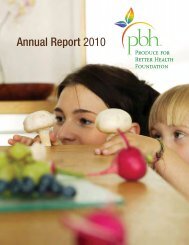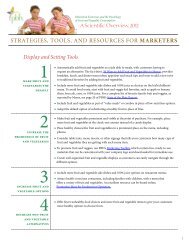The WIC Fruit and Vegetable Cash Voucher - Produce for Better ...
The WIC Fruit and Vegetable Cash Voucher - Produce for Better ...
The WIC Fruit and Vegetable Cash Voucher - Produce for Better ...
Create successful ePaper yourself
Turn your PDF publications into a flip-book with our unique Google optimized e-Paper software.
<strong>for</strong> example, how much more expensive are tomatoes in San Francisco than inNashville?Data <strong>and</strong> MethodologyWe use the 2004-06 Nielsen Homescan panel data of households to conductour analysis. (See appendix table A.1 <strong>for</strong> a comparison between NielsenHomescan data <strong>and</strong> Bureau of Labor Statistics average prices.) <strong>The</strong>se data arethe most recent available <strong>for</strong> this type of analysis, because in 2007 Nielsendiscontinued the collection of detailed data on non-universal product codedfruits <strong>and</strong> vegetables priced by the pound (“r<strong>and</strong>om weight”). <strong>The</strong> Nielsenpopulation universe is all non-grouped households (i.e., excluding institutionsor dorms) in the 48 continental States, in 52 metro areas that roughlycorrespond to the Census Bureau’s Metropolitan Statistical Areas (MSAs),<strong>and</strong> in 9 remaining non-metro areas. Due to limited sample size, we combinethe 52 metro markets into 26 aggregate market groups (see table 1 <strong>for</strong> the listof Nielsen markets in the aggregate groups). 8 Households record all of theirpurchases at a wide variety of stores, including traditional food retailers suchas grocery stores, nontraditional food retailers such as warehouse club stores<strong>and</strong> supercenters, <strong>and</strong> farmers’ markets.Nielsen Homescan data contain in<strong>for</strong>mation on food purchases <strong>and</strong> householdcharacteristics. Demographic in<strong>for</strong>mation collected from each participatinghousehold includes income range, household size <strong>and</strong> composition,<strong>and</strong> in<strong>for</strong>mation about household heads. Each household confirms or updatesthis in<strong>for</strong>mation in response to an annual survey. Householders who agree torecord all their food-related purchases are given a h<strong>and</strong>held scanner, whichthey use to enter in<strong>for</strong>mation about each purchase as they are unloadingtheir groceries at home. For items with a UPC code, data are automaticallyrecorded on such attributes as br<strong>and</strong> name, size <strong>and</strong> type of container, <strong>and</strong>specific flavor, <strong>for</strong>m, <strong>and</strong> type of the item. <strong>The</strong>se data are not collected <strong>for</strong>non-UPC items, such as fresh fruits <strong>and</strong> vegetables priced by the pound(“r<strong>and</strong>om weight” items). For scanned UPC items purchased from storesin Nielsen’s Scantrack database, the price is electronically imputed on aweekly basis as a weighted average of prices paid by all consumers, includingdiscounts from loyalty cards. Prices <strong>for</strong> items not in Scantrack are recordedby the household <strong>and</strong> are quality checked by comparing them with pricesof similar items purchased elsewhere. 9 In addition to price, in<strong>for</strong>mationsupplied by the household includes the type of store from which the item waspurchased (grocery store, warehouse club, convenience store, etc.) <strong>and</strong> thepurchase date. <strong>The</strong> household also records whether the item was on sale <strong>and</strong>whether coupons were used, which affect the final price of the item.8 For more in<strong>for</strong>mation on the aggregationof markets to market groups, seeTodd et al., 2010.9 For more details on the impact ofthis two-tiered price reporting system,see Einav et al., 2008.<strong>The</strong> Nielsen Homescan data consist of two samples: the total sample ofapproximately 40,000 households that record purchases of UPC items, <strong>and</strong>the smaller Fresh Foods Panel of approximately 8,000 households that recordpurchases of both UPC items <strong>and</strong> r<strong>and</strong>om weight items. Nielsen provides aseparate household weight <strong>for</strong> each sample based on 12 geographic areas <strong>and</strong>9 demographic variables in order to raise household data to the aggregateU.S. level (Muth et al., 2007). To compute one price <strong>for</strong> all <strong>for</strong>ms of a fruit orvegetable (canned, frozen, fresh UPC, <strong>and</strong> fresh r<strong>and</strong>om weight), we combinethe two samples by calculating an expenditure-share-weighted average priceof each <strong>for</strong>m.4<strong>The</strong> <strong>WIC</strong> <strong>Fruit</strong> <strong>and</strong> <strong>Vegetable</strong> <strong>Cash</strong> <strong>Voucher</strong>: Does Regional Price Variation Affect Buying Power? / EIB-75Economic Research Service/USDA


